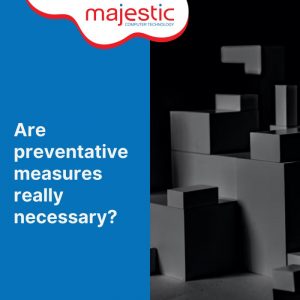Discussing levels 3 to 5 of Majestic’s Organisational Maturity model
Last week we introduced the 5 levels of the Majestic Organisational Maturity Model.
1. Initial
2. Emergent
3. Structured
4. Integrated
5. Optimised
We covered the characteristics of an organisation at both the Initial and Emergent levels. Let’s look a little higher now and turn our attention to the remaining three:
An organisation at the Structured level has a good understanding of the tools they require and how to use them. Staff know what technology to use and how to use it to achieve their required results. The challenge now is that the transfer of information between systems is still inconsistent. Some connections have been made already, and they’re working really well. But in other areas they’re not. I’s very hit and miss and as a result of that people are not sure what to expect.
Unfortunately, when you’re not sure what to expect, humans resort to the lowest common denominator, what they see as the least risky way of getting something done and that has consequences. The organisation is in a stronger position than it was at the emergent point, but is still suffering because it’s not using its tools to their best possible advantage. That creates deficiencies which result in additional cost and lost productivity.
The organisation that has overcome that barrier has become Integrated. The tools that they’re using have a clearly defined flow, with each step clear and easy to follow. It could be a workflow. It could be a handoff of information from one department to another. It might be an approval process that needs to go through five different stages in an organisation before it gets the green light and gets carried out. It could be a variety of different steps or processes that are now really nicely automated. We have a very homogeneous architecture that fits together as smoothly as a hand into a glove.
The final step, also best possible position to be in, is when all of that the above is Optimised. The organisation is now operating at its highest possible level. All tools are now perfected and automated. The architecture is completely sustained and aligned and all pieces fit together and flow into each other seamlessly. People just simply follow the bouncing ball when they’re going through the motions of delivering an outcome in their role and that manifests itself in the way in which the organisation is governed, all the way through to how outcomes are being delivered in the organisation.
MIT’s George Westerman’s seemingly light-hearted quote emphasises a vital point – that without a sound strategy in place, digital transformation does at best, very little, and at its worst, can cause more harm than benefit.
Future-ready organisations, or in other words, organisations in the Optimised state, identify the requirements of both their employees and their organisation. They then match those requirements to suitable infrastructure solutions which optimise the processes between them.
A recent Accenture study showed that on average, future-ready organisations experience at least a 1.7x higher efficiency than those at lower maturity levels and at least a 2.8x boost in corporate profitability. Across our client base, we’ve seen some significantly more impressive results.



